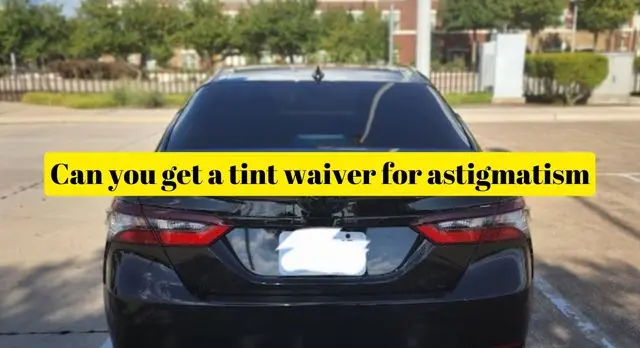If you’ve been diagnosed with astigmatism, you may be wondering if you can get a tint waiver for your vehicle’s windows in the United States. Astigmatism is a common eye condition that can make you more sensitive to bright light and glare. In this comprehensive guide, we’ll explore the possibility of obtaining a tint waiver for astigmatism in the USA, including the requirements, the application process, and what you need to know to legally tint your car windows for improved comfort and vision.
Understanding Astigmatism and Light Sensitivity
Astigmatism is an eye condition that occurs when the cornea or lens of the eye has an irregular shape. This irregularity can cause blurred or distorted vision, and it often leads to increased sensitivity to light. Bright sunlight and glare from oncoming headlights can be particularly bothersome for individuals with astigmatism, making driving a challenge.
Tinting the windows of your vehicle can help reduce the discomfort caused by excessive light and glare, making it a valuable option for individuals with astigmatism. However, it’s important to understand the legal aspects and requirements for obtaining a tint waiver.

Can You Get a Tint Waiver for Astigmatism in the USA?
The possibility of obtaining a tint waiver for astigmatism varies from state to state in the USA, as tinting laws are typically regulated at the state level. While some states may offer medical exemptions for window tint for specific eye conditions, others may not have such provisions.
To determine whether you can get a tint waiver for astigmatism in your state, you should:
- Check Your State’s Tinting Laws: Research the tinting laws and regulations in your specific state. Look for any provisions related to medical exemptions for window tint.
- Consult Your Eye Doctor: Discuss your astigmatism and sensitivity to light with your eye doctor. They can provide guidance on whether a tint waiver might be beneficial for your condition and if it aligns with your state’s regulations.
- Contact Your State’s Department of Motor Vehicles (DMV): Reach out to your local DMV or similar agency to inquire about the process for obtaining a tint waiver, if available.
Steps to Apply for a Tint Waiver for Astigmatism
If you determine that your state offers a medical exemption for window tint and that your astigmatism qualifies, here are the general steps to apply for a tint waiver:
- Consult Your Eye Doctor: Schedule an appointment with your eye doctor to discuss your condition and the need for a tint waiver. They may need to provide a letter or certificate verifying your condition.
- Gather Documentation: Collect any required documentation, including medical records and the necessary forms provided by your state’s DMV or relevant agency.
- Complete the Application: Fill out the application form for the tint waiver, providing accurate information and attaching any supporting documents.
- Submit Your Application: Submit your completed application and documentation to the appropriate agency, following their specific guidelines and procedures.
- Wait for Approval: Wait for the agency to review your application. If approved, you will receive a tint waiver that specifies the allowable level of tint for your windows.
Key Takeaway
Obtaining a tint waiver for astigmatism in the USA can be possible in certain states that offer medical exemptions for window tint. However, it’s essential to research your state’s specific regulations, consult with your eye doctor, and follow the correct application process. Tint waivers are typically granted to improve comfort and vision for individuals with medical conditions like astigmatism, making it worth exploring if you experience light sensitivity due to your condition. Always stay informed about your state’s tinting laws, as they may evolve over time.
Related Guide – How to get a tint waiver in Maryland?
FAQs About Getting a Tint Waiver for Astigmatism in the USA
What is astigmatism, and how does it affect sensitivity to light?
Astigmatism is an eye condition characterized by an irregular shape of the cornea or lens, leading to distorted vision. People with astigmatism often experience increased sensitivity to bright light and glare, making driving uncomfortable.
Can I get a tint waiver for astigmatism in the USA?
The possibility of obtaining a tint waiver for astigmatism varies by state in the USA. Some states offer medical exemptions for window tint, which may apply to individuals with astigmatism. It’s crucial to research your state’s specific regulations to determine eligibility.
How can I find out if my state offers a tint waiver for astigmatism?
To determine if your state offers a tint waiver for astigmatism, you should check your state’s tinting laws, consult your eye doctor, and contact your local Department of Motor Vehicles (DMV) or relevant agency for information on available exemptions.
Which states in the USA have medical exemptions for window tint?
Some states with medical exemptions for window tint include California, Florida, Arizona, Michigan, and Ohio. However, the availability and requirements for exemptions can change, so always check with your state’s DMV for the most current information.
Are tint waivers permanent, or do they need to be renewed?
Tint waivers may have expiration dates and require renewal. The renewal process will likely involve reevaluating your medical condition and providing updated documentation.
Can I transfer a tint waiver from one state to another if I move?
Tint waivers are typically issued by individual states and may not be transferable between states. If you move to a different state, you may need to reapply for a new tint waiver according to the regulations of your new state of residence.
What should I do if my state doesn’t offer a tint waiver for astigmatism?
If your state does not offer a tint waiver for astigmatism, you may need to comply with the standard window tinting laws and regulations in your state. Consider wearing sunglasses and using other means to reduce sensitivity to light while driving.
